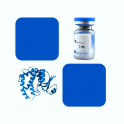
- Remove this product from my favorite's list.
- Add this product to my list of favorites.
Products
Newsletter
 |  |  |  |  |  |

Background
CTLA-4 (Cytotoxic T-Lymphocyte Antigen 4) is also known as CD152 (Cluster of differentiation 152), is a protein receptor that downregulates the immune system. CTLA4 is a member of the immunoglobulin superfamily, which is expressed on the surface of Helper T cells and transmits an inhibitory signal to T cells. The protein contains an extracellular V domain, a transmembrane domain, and a cytoplasmic tail. Alternate splice variants, encoding different isoforms. CTLA4 is similar to the T-cell co-stimulatory protein, CD28, and both molecules bind to CD80 and CD86, also called B7-1 and B7-2 respectively, on antigen-presenting cells. CTLA4 transmits an inhibitory signal to T cells, whereas CD28 transmits a stimulatory signal. Intracellular CTLA4 is also found in regulatory T cells and may be important to their function. Fusion proteins of CTLA4 and antibodies (CTLA4-Ig) have been used in clinical trials for rheumatoid arthritis.
Source
Recombinant Human CTLA4 /CD152 Protein, Fc Tag (CT4-H5255) is expressed from human 293 cells (HEK293). It contains AA Ala 37 - Ser 160 (Accession # P16410-1).
Predicted N-terminus: Ala 37
Molecular Characterization
This protein carries a human IgG1 Fc tag at the C-terminus.
The protein has a calculated MW of 39.9 kDa. The protein migrates as 45-55 kDa under reducing (R) condition, and 90 kDa under non-reducing (NR) condition (SDS-PAGE) due to glycosylation.
Endotoxin
Less than 1.0 EU per μg by the LAL method.
Purity
>98% as determined by SDS-PAGE.
>90% as determined by SEC-MALS.
Formulation
Lyophilized from 0.22 μm filtered solution in Tris with Glycine, Arginine and NaCl, pH7.5 with trehalose as protectant.
Reconstitution
See Certificate of Analysis for reconstitution instructions and specific concentrations.
Storage
For long term storage, the product should be stored at lyophilized state at -20°C or lower.
Please avoid repeated freeze-thaw cycles.
This product is stable after storage at:
-20°C to -70°C for 12 months in lyophilized state;
-70°C for 3 months under sterile conditions after reconstitution.
Bioactivity
Please refer to product data sheet.
(1) "INDUCIBLE MONOVALENT ANTIGEN BINDING PROTEIN"
Authors: Baeuerle Patrick, et al
Journal: US20200148771A1 2020
Application: ELISA
(2) "Vaccine protection against rectal acquisition of SIVmac239 in rhesus macaques"
Authors: L Gonzalez-Nieto, et al
Journal: PLoS Pathog 2019
Application: ELISA
Recombinant human CTLA4/CD152 Protein, His Tag, 100µg - 221,00 €
Recombinant Cynomolgus / Rhesus macaque CTLA-4 Protein, His Tag, 200µg - 260,00 €
Recombinant Cynomolgus / Rhesus macaque CTLA-4 Protein, Fc Tag, 200µg - 260,00 €
Recombinant Biotinylated Cynomolgus / Rhesus macaque CTLA-4, Avi Tag (Avitag™), 25µg - 468,00 €
Follow us